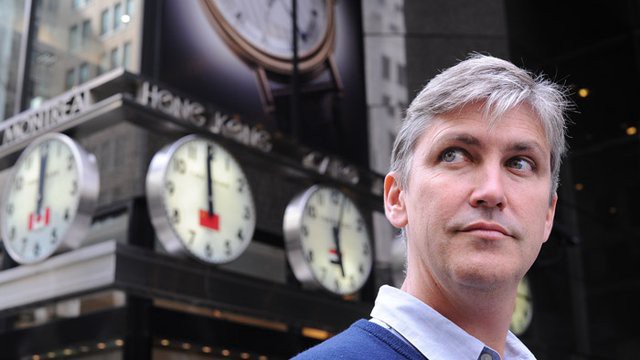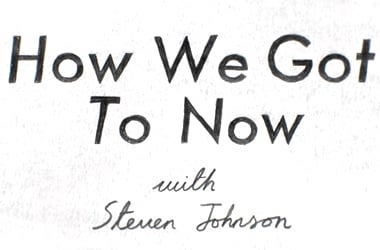

The second episode of How We Got To Now focuses on the idea of time. We asked Steven Johnson for some behind-the-scenes stories.
What was the most surprising idea you discovered in making this episode?
I love the whole idea that until 1880 or so, every single town in America was effectively on its own time zone. Each town would vary from the town to its east or west by a few minutes. It’s the sort of problem that doesn’t seem like a problem until a new technology comes along to expose it–in this case, the railroad, which suddenly caused people to travel between towns at great speeds according to precise schedules. And so, suddenly, everyone’s sense of time got confused, and we needed to standardize time zones to solve the problem.
Many of the ideas you discuss developed a long time before they had their biggest impact. What was the biggest “slow hunch” in this episode?
Galileo’s vision of a pendulum clock–one of the most important breakthroughs in the history of timekeeping–also happens to be the slowest hunch I have ever encountered. He started thinking about the idea as a teenager and didn’t fully develop the concept for another 50 years! Sometimes you really do have to be patient with your ideas. Of course, Galileo had quite a bit on his plate.
What was the most incredible moment in filming this week’s episode?
I was quite amazed that they let me stand right next to the computer that determines all official time for the United States and for all the GPS satellites (which are dependent on the nano-second accuracy of atomic clocks). We were shooting in the room with this machine by ourselves for almost an hour; as I said on camera, I felt like I could just mess with some of the switches and the entire nation would be late for work.
Was there a story or idea that you loved that didn’t make it into the final episode?
We had a riff that we tried to shoot about all the layers of knowledge that you rely upon when you glance down at your phone to tell what time it is. It was just a little too abstract, I think, for the show, but I put it in the book:
“Embedded in your ability to tell the time is the understanding of how electrons circulate cesium atoms; the knowledge of how to send microwave signals from satellites and how to measure the exact speed with which they travel; the ability to position satellites in reliable orbits above the earth, and of course the actual rocket science needed to get them off the ground; the ability to trigger steady vibrations in a block of silicon dioxide–not to mention all the advances in computation and micro-electronics and network science necessary to process and represent that information on your phone. You don’t need to know any of these things to tell the time now, but that’s the way progress works: The more we build up these vast repositories of scientific and technological understanding, the more we conceal them.”
This week’s episode is about time. What is the most important idea or innovation on this theme emerging right now?
It’s funny–one of the stories we tell in this episode involves the Ellery Watch from the 1860s, which was the first consumer watch affordable for a mass audience. In a way, it was the first piece of consumer technology that was a big runaway hit–the predecessor to the iPhone and iPod, etc. And I suppose we are now back full circle, waiting for the Apple Watch to come out. The basic functionality of a wristwatch hasn’t really changed for 300 years; it has used different timekeeping mechanisms, of course, but it’s basic function has remained consistent: telling you the time. But that may all be about to change, just as the basic function of a phone changed almost a decade ago. I’m really looking forward to seeing how it all turns out!


How We Get To Next was a magazine that explored the future of science, technology, and culture from 2014 to 2019. Steven Johnson’s How We Got To Now was published by Riverhead Books in 2014, and adapted into a six-part TV show by Nutopia for PBS in 2015. Click the logo to read more about how the show was made.
